[German version | List of historical bars]
On Friday 10 June 1870, a certain G. Arnoldi opened a cocktail bar in Berlin at the prestigious address Unter den Linden 61.
This was not quite a year before the founding of the German Empire, a good century before the opening of Harry’s New York Bar in Munich and 150 years before Wax On opened its doors in Neukölln. William Terrington’s Cooling Cups had been published for the first time in London a year earlier, Jerry Thomas’ Bar-Tender’s Guide eight years earlier in New York. Little is known about what was perhaps the first bar on German soil. Only four adverts in a Berlin newspaper have been found to date. Nonetheless, they form an important piece of the mosaic for our picture of the beginnings of cocktail culture in Germany.
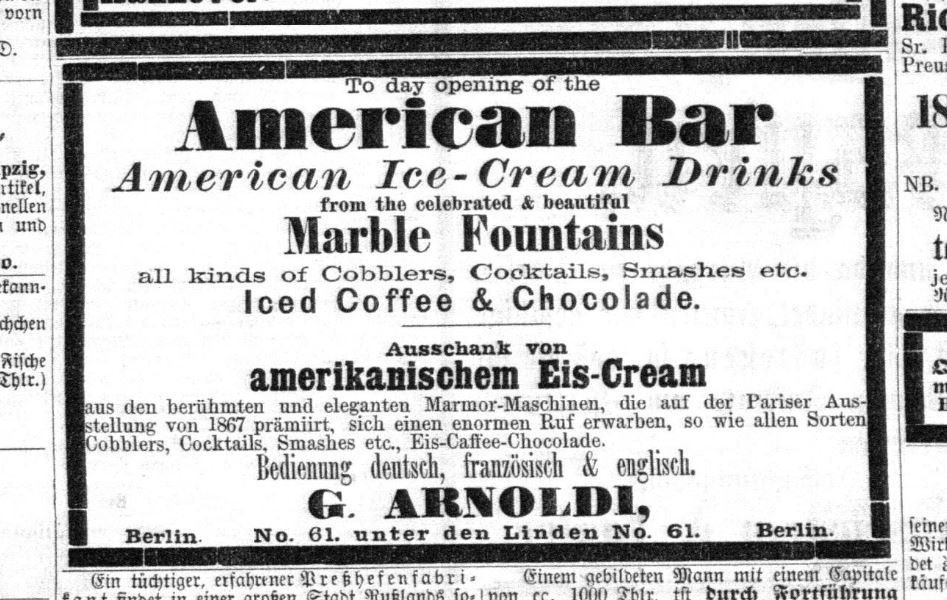
The sting of the Berlin Wasps
For the day of the opening, Mr Arnoldi had placed a rather generous advertisement in the supplement of the Berliner Wespen (“Berlin Wasps”) to draw attention to the new gastronomic attraction. The Berliner Wespen had been launched two years earlier as an “Illustrated humorous Sunday paper” by Julius Stettenheim. Born in Hamburg, he had studied at the Friedrich Wilhelm University in Berlin from 1857 to 1860, but was unable to travel to Berlin in the meantime because a warrant had been issued for his arrest in Prussia for satirical articles about Otto von Bismarck. The already limited freedom of the press had been further restricted in the years following the March Revolution.

Before the Free City of Hamburg was absorbed into the German Empire in 1871 and Stettenheim might no longer have been safe in his hometown, he was granted an amnesty in 1866, which enabled him to return to Berlin. Alongside Kladderadatsch (since 1848) and Ulk (from 1872), his Wespen became one of the leading satirical papers of the imperial era. The weekly Wespen could be obtained by subscription or as a supplement to various other Berlin newspapers. Even though the paper was close to the liberal German Progress Party, it was not a party organ,[1] which presumably made it an attractive advertising medium for G. Arnoldi, as did its wide distribution in Berlin.
Fig. left: German humourists of modern times (detail), lithograph by Hermann Scherenberg, in Illustrirte Zeitung No. 1905, 08.01.1880, 8).
Spree-Chicago avant la lettre
“American Bar” is emblazoned in bold letters above further information about what awaited guests in the new restaurant. The upper part of the advert is in English and the Fraktur font, which is perceived as German and was otherwise still very present in the newspapers, is avoided altogether. What was advertised here was intended to be perceived as thoroughly American, new, and modern. This was certainly intended to appeal to German guests, but probably above all to the Americans who lived in Berlin. Although there was not yet an English-language newspaper in Berlin that would have appealed to the American audience in particular,[2] it was nonetheless a time when the American community in Berlin had already grown so large that the English-language Sunday masses could no longer be held in the spacious private flat of the German-American missionary pastor Ludwig Nippert. He had received permission to do so from the Methodist Episcopal Church (MEC) in 1859. In 1876, the American Chapel in Junkerstraße in Kreuzberg was able to start operations. In 1903, it was replaced by the American Church in Motzstraße on Nollendorfplatz in Schöneberg, which was newly built by Otto March and existed until its destruction in 1943.[3]

But what does a church have to do with a 30-year-old cocktail bar? G. Arnoldi’s newly opened saloon can be seen as part of a development that was already underway in 1870 and was to gather momentum over the next few decades:[4]
„Es gab ein »American Quarter« rund um die »American Church« am Nollendorfplatz. Amerikanische Herrenanzüge waren um 1910 groß in Mode, ebenso wie der aus den USA importierte Boxsport, das Rollschuhlaufen und Cocktailbars. Amerikanische Versicherungsgesellschaften legten ihr Geld in Berliner Immobilien an. Wie New York besaß Berlin seinen Lunapark, einen großen Vergnügungspark am Halensee mit Wasserrutschbahn und Teufelsrad, Lachhaus und »Moulin Rouge«.“
“There was an “American Quarter” around the “American Church” on Nollendorfplatz. American men’s suits were all the rage around 1910, as were boxing, roller skating and cocktail bars imported from the USA. American insurance companies invested their money in Berlin property. Like New York, Berlin had its Lunapark, a large amusement park at Halensee with a water slide and devil’s wheel, a laughing theatre and a “Moulin Rouge”.”
In fact, before the First World War, 200 metres from the American Church, the Motz Bar was to open at Motzstraße 21, which will be discussed elsewhere. In terms of urbanity, modernity, and speed, the Berlin of the imperial era had a city character that made Mark Twain speak of the “Chicago of Europe” in 1892. The catchphrase “Spree-Chicago” became established in German literature and the press.[5]
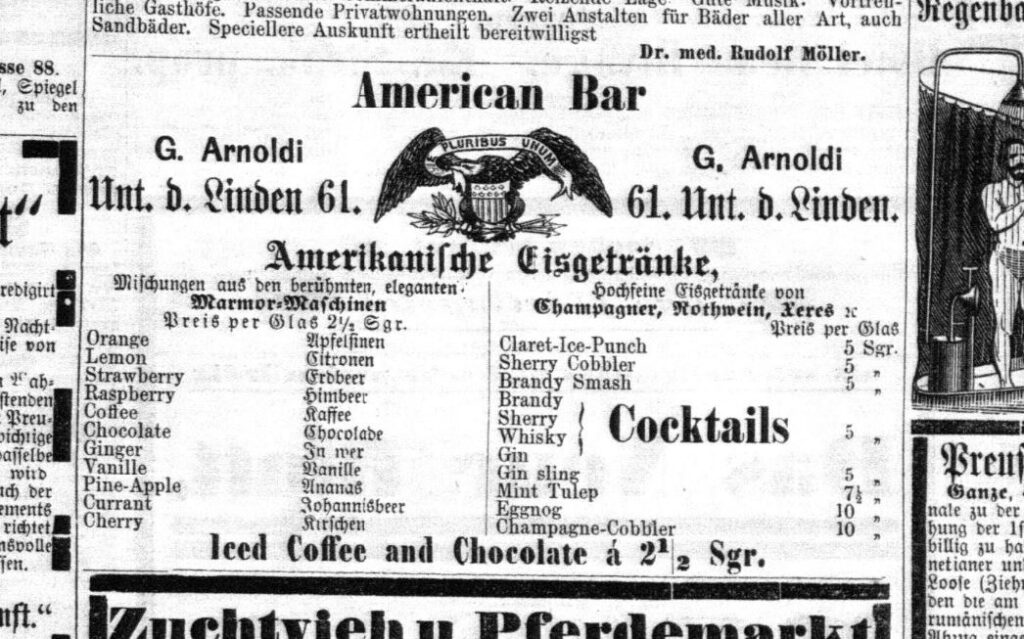
In two adverts that Arnoldi placed in the following weeks in the supplement to the Wasps, the reference to America was made even clearer by a graphic element that probably drove up the cost of the advertising space once again: Flying above the text is the Bald Eagle, which bears the Stars and Stripes emblem on its chest and grasps arrows and olive branches with its talons as symbols of war and peace. In his beak he holds the banner with the inscription “E PLURIBUS UNUM”. The depiction corresponds to the Great Seal of the United States, which has served as the national emblem since 1782.[6] The Latin phrase on the banner literally means “out of many one”, which can be summarised with Leibniz as “unity in multiplicity”. This Neoplatonic-influenced idea already appeared several times in antiquity in the writings of the church father Augustine (e.g. Aug. conf. 4,8,13), whom the founding fathers of the United States had read thoroughly. The latter had possibly borrowed the phrase from Cicero (Cic. Lael. 25,92; off. 1,17,56), who was also not unknown to the like of Benjamin Franklin, John Adams and Thomas Jefferson.[7] It is possible that G. Arnoldi had given more thought to advertising his new type of restaurant than simply looking for visual references to America: The much-vaunted metaphor of the “melting pot USA” symbolises a vessel in which different things are brought together in a liquid state, and thus corresponds to the cocktail principle – only at a different temperature.
We all scream for »Eis-Cream«
Initially, the adverts focused on the availability of ice and the iced drinks and ice cream made from it. In particular, the “Marmor-Maschinen” (“marble machines”) that supplied the ice cream were emphasised as an attraction and unique selling point. It is likely that the marble was only used to clad the actual machines or the containers for the ice produced. Ice was not yet omnipresent in Prussia on the eve of the imperial era and could not easily be produced in every household. Arnoldi wanted his advertising to appeal to the enthusiasm for progress and technology of advanced industrialisation. The opening advert even refers to the success of his refrigeration technology three years earlier at the Paris World Exhibition. In fact, two Frenchmen named Carré had caused an international furore with a process in which ice crystals could be produced from the remaining water by absorbing part of the water in acid. Even in contemporary reports, however, there is a certain amount of confusion about the two Carrés. The most plausible account is the one according to which Edmond Carré presented his air-pump sulphuric acid machine in 1850, with which he was able to produce 340 grams of artificial ice in 45 minutes, i.e. about two drinking glasses full.
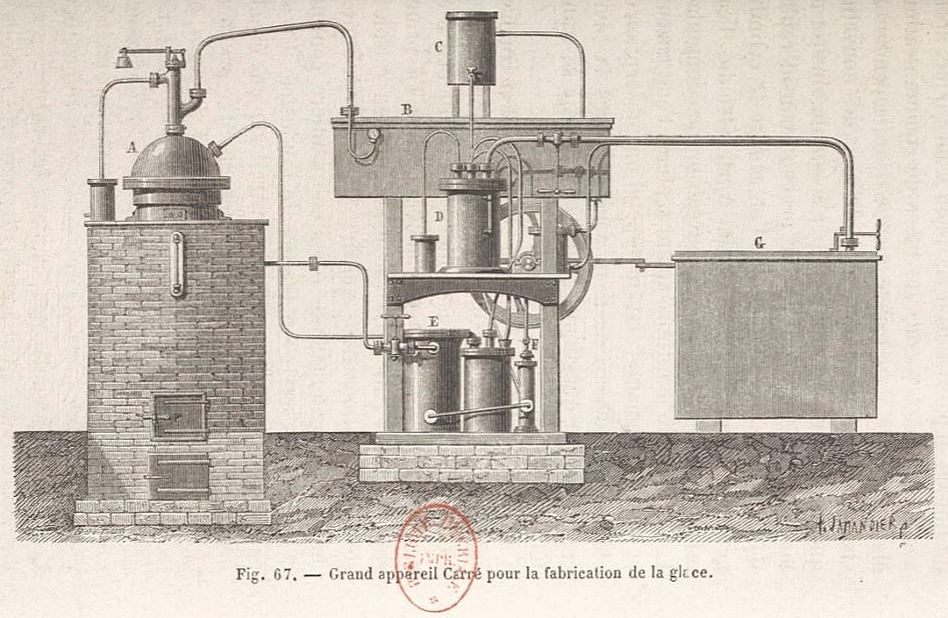
At the Paris World Exhibition, however, it seems to have been his older brother Ferdinand Carré’s further development from 1859 that was ground-breaking. This machine could produce 200 kilograms of ice per hour using slightly less dangerous sulphuric acid[8] – which made the device much more interesting for commercial use. The illustrations of the unadorned containers and tubes of the Carré machines make it clear that marble panelling had a certain added value in terms of aesthetics and safety. In any case, Arnoldi must have dug deep into his pockets for the apparatus.
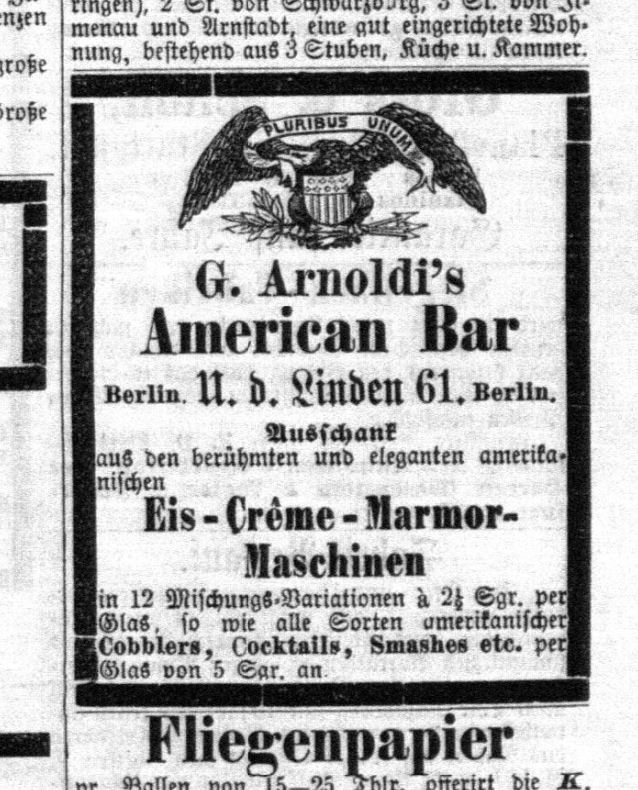
In addition to various, apparently non-alcoholic ice cream specialities, he initially advertised “Cobblers, cocktails, smashes etc.” across the board, only to subsequently list a larger selection of the refreshments on offer. “Claret-Ice-Punch”, “Sherry Cobbler”, “Brandy Smash” and the like are no great surprises by the American standards of the time, but we are in the stuffy Prussia of 1870, so a little surprise is certainly appropriate. The fact that Arnoldi advertised a “Mint Tulep” does not necessarily have to be blamed on him, perhaps he had ordered the adverts by phone. The person who prepared the adverts for the Wasps had perhaps never had a julep before. However, the fact that the error appeared again the following week seems to be at least a lack of care on Arnoldi’s part. The three “cocktails” in the list, which were obviously expected to have greater appeal than, for example, “Eggnogg”, are highlighted in bold. We learn nothing about the recipes for the drinks, but the prominence of ice in the adverts is evidence of at least one aspect of cocktails that Arnoldi must have got right. Despite advances in refrigeration technology, ice was not yet a ubiquitously available consumer good, even for better-off private households, so it is understandable that the American Bar presented itself primarily as an ice bar.

It is a stroke of luck that the prices are indicated. The alcohol content of the drinks in the right-hand column can already be seen from the two to four times higher price level compared to the left-hand column. At 10 Prussian silver groschen (Sgr.) each, the “Champagne Cobbler” (probably because of the main ingredient) and the “Eggnogg” (perhaps because of the effort) were the most expensive. The next cheapest drink was the Mint Julep at 7½ Sgr, which was possibly more expensive than cocktails, which were available at 5 Sgr each, due to the larger amount of ice to be used. According to conversion tables in modern currencies, a cocktail would have cost €4.95 and a champagne cobbler €9.90.[9] But were the prices really as much like a land of milk and honey as it sounds? For example, a typesetter working in a print shop was paid 97.50 marks per month in 1872,[10] which, according to Art. 15 No. 3 of the Coinage Act of 9 July 1873, corresponded to the value of 975 Sgr. or 32.50 talers. According to the conversion table quoted above, an evening at G. Arnoldi would have had to be paid from a monthly salary of € 741. In short: the fact that cocktails have their price in Germany is a historical constant – which certainly comes as no surprise to anyone who has ever calculated prices for a bar.
It should also be noted that our American Bar did not advertise a visit with music, dancing or variety shows. The German understanding of the English loanword “Bar” was to shift significantly in this direction in the following decades. Here on Unter den Linden in 1870, however – as is the case for most barflies today – it was all about well-chilled cocktails.
G as in Gretchen – or as in Gustav?
What can be said about G. Arnoldi? Theoretically, the figure who gave the bar its name need not even have been identical to its publican. But with an artificial name, you have to ask yourself what advertising effect the bar owner of the unknown name was hoping to achieve. An American-sounding name would be more likely than an Italian-sounding one. So G. Arnoldi was probably the name of the publican. It is by no means certain that he was a man, but the circumstances of the time make it likely: the Berlin address books of the 19th century – comparable to the telephone directories of the 20th century – sometimes contain quite extensive information on the registered residents, including the occupation practised. First names are also abbreviated here, but for the address book of 1870 there are 615 entries with the job title “Schankwirth” (innkeeper) compared to just 19 entries with the female form “Schankwirthin”. There is therefore a 96.8 % probability that our bar owner was a man.
However, despite all the wealth of information in the Berlin address books of the 1870s, one person who does not appear at all is our G. Arnoldi. This could speak in favour of an artificial name, but there may also be other reasons. It is quite possible that Arnoldi was not registered and therefore fell through the cracks in the address books. The rapidly growing Berlin of the second half of the 19th century suffered from a severe housing shortage with all its accompanying symptoms such as poverty, usurious rents, and speculation. In the summer of 1872, there were even riots in which several thousand Berliners took part.[11] Despite its ban, bed lodging was also widespread, whereby homeless people rented beds in private homes by the hour while they went about their daily business. It is hard to imagine that Arnoldi, as a small businessman, would have been a so-such a bed lodger. On the other hand, the proportion of bed lodgers in Berlin flats rose from 13.6 % in 1861 to an impressive 22.7 % in 1875.[12] The early modern Airbnb precursor was therefore not a marginal phenomenon. Finally, the explanation for Arnoldi’s absence from the annually published address books could also be found in the sad circumstance that he had to close his establishment before the 1871 address book went to press and his entry therefore fell into the gap between two issues.
Strictly speaking, until other evidence is found, one would have to reckon with the possibility that Arnoldi had booked the adverts in the Wespen some time in advance, but in the end the bar never opened. Perhaps the ice machines had not been delivered or he was unable to raise the necessary start-up capital because promised money did not materialise. As a passionate cocktail lover, we can only hope that we are not just looking at the traces of a failed business plan.
There goes the neighborhood

Today, the Russian embassy, which opened in 1952, is located at Unter den Linden 61. At the beginning of the imperial era, however, the houses were still numbered according to the horseshoe principle introduced in 1799, which can still be admired today on Kurfürstendamm, for example: consecutive numbers, starting at 1 on one side of the street, continued at the end on the opposite side of the street and numbered there in the opposite direction, so that the lowest and highest house numbers are opposite each other. When the boulevard Unter den Linden was extended to the Schlossbrücke in the west in 1937 to the glory of the Third Reich, the zigzag principle that is familiar today was applied. In 1870, the shop of Arnoldi’s American Bar was located opposite today’s Russian embassy on the stretch between Schadowstraße and Neustädtische Kirchstraße, where today the Otto-Wels-Haus from the 1960s puts the splendour of the boulevard in its place.
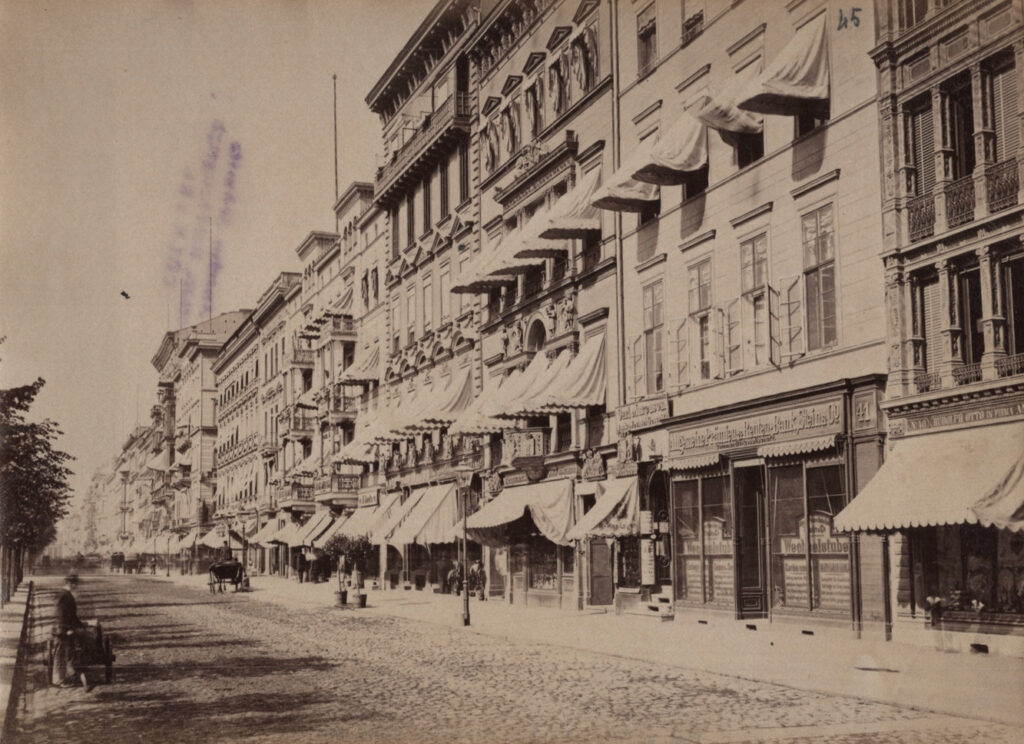
In 1870, apart from a number of government buildings and authorities, Unter den Linden was characterised by relatively narrow or normal-sized houses, which generally had no more than three to four floors of offices or flats above a shop. Most of the shops on the north side protected themselves from the sun with awnings, which gave the rows of houses a flair reminiscent of holiday resorts on the Belgian Atlantic coast in old photographs. No. 61 was one of the narrow houses that probably only provided space for a single shop. This is interesting in that the Stuhr’sche book shop, which had previously operated on the south side at Unter den Linden 8,[13] moved into the premises at number 61 in 1874.[14] Presumably G. Arnoldi’s Bar was no longer in existence by this time at the latest.
Germany casting its shadow ahead

One of the more beautiful depictions of the boulevard Unter den Linden now hangs in the Old National Galery and, like many other paintings there, was created by Adolph von Menzel. It shows a crowd of people watching from the pavement as the Prussian King Wilhelm I is driven to the army in a carriage. The people are dressed in their Sunday best, have brought their children with them and are waving to the monarch. A few uniformed men salute in the crowd and in the foreground an elderly gentleman, who has taken off his top hat, bows. This almost idyllic scene of an urban summer’s day takes place on 31 July, twelve days after a disastrous development in Western Europe had led to France’s foreseeable declaration of war. This was barely six weeks after G. Arnoldi had opened his American Bar. However, it is more than uncertain that the war had anything to do with the fact that the novel establishment with its elaborate ice machines was apparently unable to survive for long. In any case, Wilhelm I returned to the Old Palace on Unter den Linden in January 1871 as Kaiser of the newly founded German Empire.
[Translated from German with the help of deepl.com.]
Notes
[1] Art. Berliner Wespen, in: Wikipedia. Die freie Enzyklopädie, https://de.wikipedia.org/wiki/Berliner_Wespen, retrieval: 09.12.2023.
[2] From 1906 to 1910, “The Dresden Daily” was published in Dresden, by its own admission the first English-language newspaper in Germany, which appeared from 1907 under the title “The Daily Record” and was also published in Berlin from 20 October of the same year, https://digital.slub-dresden.de/werkansicht/dlf/120620/1.
[3] American Church Berlin. An Ecumenical International Protestant Church, Church History, https://americanchurchberlin.de/about/church-history/, retrieval: 16.11.2023.
[4] Michael Bienert & Elke Linda Buchholz, Modernes Berlin in der Kaiserzeit. Ein Wegweiser durch die Stadt, 1. Auflage der überarbeiteten und aktualisierten Neuauflage, Berlin: Berlin Story 2016, 12.
[5] Bienert & Buchholz 2016, 11 f.
[6] Art. Großes Siegel der Vereinigten Staaten, in: Wikipedia. Die freie Enzyklopädie, https://de.wikipedia.org/wiki/Gro%C3%9Fes_Siegel_der_Vereinigten_Staaten#Geschichte, retrieval: 10.12.2023.
[7] Wolfgang Hübner, E pluribus unum. Augustinus und die Vereinigten Staaten von Amerika, in: Revue d’études augustiniennes et patristiques 57 (2011) 137-144, https://www.augustinus.de/artikel/113-artikel-beitrag-vortrag/189-e-pluribus-unum-augustinus-und-die-vereinigten-staaten-von-amerika, retrieval: 09.11.2023.
[8] Hydrochloric acid has a pKS value of -6, sulphuric acid -3, both are very strong acids. Vgl. Tabelle der pKS Werte und allgemeiner Eigenschaften gebräuchlicher Säuren und Basen, https://www.cerevisia.at/usr_upload/pks_tabelle.htm, retrieval: 10.12.2023.
[9] Deutsche Bundesbank, Kaufkraftäquivalente historischer Beträge in deutschen Währungen, 15.03.2023, https://www.bundesbank.de/de/statistiken/konjunktur-und-preise/-/kaufkraftaequivalente-historischer-betraege-in-deutschen-waehrungen-615162, retrieval: 03.12.2023.
[10] Ulrich Pfister, Löhne und Konsumgüterpreise in Deutschland 1850 bis 1889 (2019), GESIS Datenarchiv, Köln. ZA8710 Datenfile Version 1.0.0, https://doi.org/10.4232/1.13334, A.01.04b: Einzelne Lohnreihen (in Mark) – Druckereigewerbe: Wochenlohn, 1872-1889. The older wage series refer to wages per 1,000 set letters.
[11] Kerstin Hilt, Krawalle wegen Wohnungsnot in Berlin (25.7.1872), Podcast ZeitZeichen, 25.07.2022, https://sr-mediathek.de/index.php?seite=7&id=26471&tbl=pf, retrieval: 10.12.2023.
[12] Johann Friedrich Geist, Klaus Kürvers: Das Berliner Mietshaus 2, München: Prestel 1980, 469.
[13] Berliner Adreßbuch 1873, 317, Digitale Landesbibliothek Berlin, https://digital.zlb.de/viewer/image/34111732_1872/1216/, retrieval: 10.12.2023.
[14] Berliner Adreßbuch 1874, 424, Digitale Landesbibliothek Berlin, https://digital.zlb.de/viewer/image/34115512_1874/1389/, retrieval: 10.12.2023.